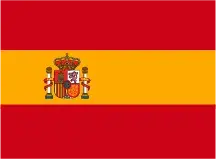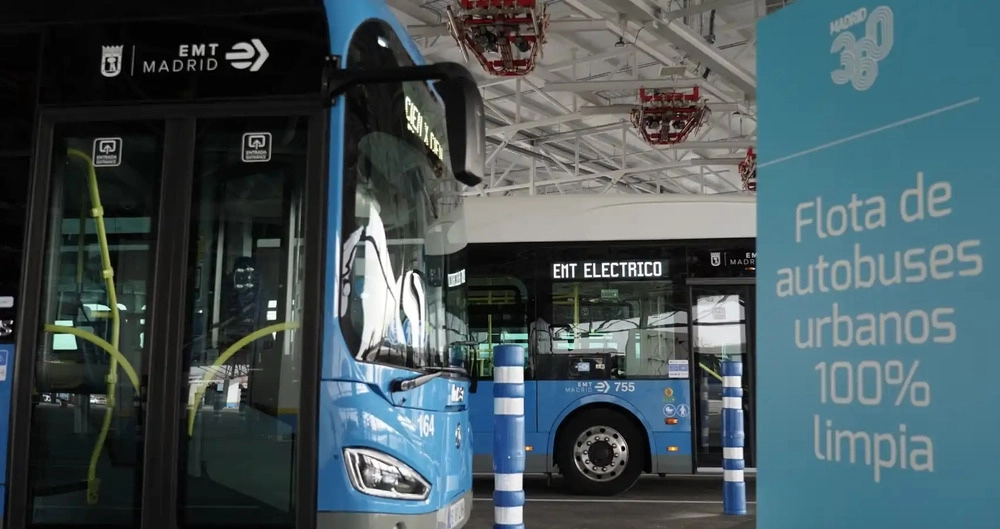This December marks one year since the withdrawal of the last diesel municipal buses from the Municipal Transport Company (EMT in Spanish).
Since then, this milestone has been recognized as a turning point that made Madrid the first Spanish city—and one of the first capitals in Europe—with a 100% clean bus fleet, in line with the requirements of the European Directive on Clean Vehicles.
But the ambition doesn’t stop there.
The Delegate of the Department of Urbanism, Environment, and Mobility, Borja Carabante, accompanied by the Managing Director of the Municipal Transport Company of Madrid, Alfonso Sánchez, has announced the electrification goals for the municipal fleet for the coming year.
In this regard, he has revealed “the recent awarding of a total of 100 new electric buses that will be gradually added to the municipal fleet between March and December 2024.”
Thus, by the end of 2024, EMT Madrid will have 440 zero-emission electric buses, and by 2025, 25% of the fleet will be electric.
According to data collected by Mobility Portal España, the entire municipal fleet consists of 2,038 buses, of which 1,811 are Compressed Natural Gas (CNG) buses (88.9%), 5 are plug-in CNG hybrids (0.24%), and 222 are 100% electric vehicles (10.9%).
A noteworthy fact is that the fleet has an average age of 4.55 years, making it the youngest in Spain and the second youngest in Europe, after Berlin.
Alongside London and Paris, Madrid stands among the European capitals with the highest number of electric buses by the end of the year.

Which brands secured the award?
As reported, a total of 80 are standard 12-meter buses, of which 50 bear the signature of the Chinese company BYD but with Castrosua bodies.
The remaining 30 will be supplied by Solaris. 20 units of this award are electric midi-buses (9.3 meters), also from the same European manufacturer.
The award for these hundred buses amounts to €54,845,000, of which EMT will receive €200,000 per bus from the Next Generation EU funds.
This contribution is part of the Recovery, Transformation, and Resilience Plan, specifically in the 2022 call for assistance to municipalities for the implementation of low-emission zones and the digital and sustainable transformation of urban transport.
Simultaneously, EMT is awaiting the arrival of 11 buses this December, which will start operating in early 2024, and another 44 electric ‘ie bus’ models from Irizar, scheduled to arrive in the first quarter of 2024.
Additionally, EMT and the City of Madrid have adhered to the commitment made over the years to provide the necessary infrastructure at the company’s operation centers to supply energy to the new electric vehicles being integrated into the municipal fleet.
The arrival of the first green hydrogen buses
In addition to emphasizing the use of electric power for the fleet, the municipal company is immersed in a major project to acquire models powered by green hydrogen.
It is expected that these buses will cover the entire production and storage cycle of this fuel at their own facilities.
The first 10 green hydrogen buses were promised to arrive in 2023, and more will continue to arrive throughout 2024.
Furthermore, a batch of 150 fully electric buses has been gradually incorporated into the municipal fleet this year.
An important factor is that EMT is working on installing a hydrogen station at its La Elipa district depot.
Currently, they have begun the construction of the first hydrogen plant in the capital, located at the EMT Operations Center.
There, they hope to refuel the 10 hydrogen-powered buses from the Portuguese manufacturer CaetanoBus.
The project includes the installation of a total of 2,780 photovoltaic panels distributed across three ramps, with a maximum power of 1.6 MWh, 550 kW for each panel.
The path to decarbonization
The decarbonization of the municipal bus fleet is one of the main goals set by EMT and the City Council with million-dollar investments for this purpose, as outlined in the EMT Strategic Plan until 2025.
The three major projects to achieve this goal are the acquisition of zero-emission buses, the adaptation and construction of new sustainable infrastructures at their operation centers, and the use of technologies applied to mobility and clean energy.
Regarding the first of these major projects, EMT and the City of Madrid are advocating for a progressive electrification that aims to make 25% of the municipal fleet electric by 2025.
Currently, Madrid already has 28 zero-emission bus lines (the latest being Line 17, which has exclusively electric vehicles), making it the Spanish city with the most 100% electrified routes.
The zero-emission fleet of the municipal company comprises 270 units as of the end of 2023, and it is expected that by 2024, the number will reach 440 units of zero-emission buses.
Regarding the construction of new infrastructures outlined in the EMT Strategic Plan until 2025, the launch of an intelligent electric charging station using inverted pantograph at its Carabanchel facilities stands out—a pioneering project that has been operational for months.
Simultaneously, the EMT Operations Center in La Elipa—with a capacity for 318 buses—is gearing up to become a reference center for the management of a 100% electric fleet and will be equipped with a photovoltaic installation designed for energy supply.








